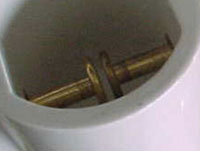Put simply, a dielectric breakdown voltage test is a measure of the electrical stress that an insulating oil can withstand without breakdown. The test is performed using a test vessel that has two electrodes mounted in it, with a gap between them. A sample of the oil to be tested is put into the vessel and an AC voltage is applied to the electrodes. This voltage is increased until the oil breaks down - that is, until a spark passes between the electrodes. The test voltage is then immediately turned off. The voltage at which breakdown occurred is the test result, and is typically evaluated by comparing it with guidelines set out in various standards, or in the oil manufacturer's specifications.
The exact method of performing the test is determined by the standard that is being used. The standard typically defines parameters such as the size and shape of the electrodes, the gap between them, the rate at which the test voltage is increased, how many times the test is repeated and whether or not the oil is stirred during the test.




